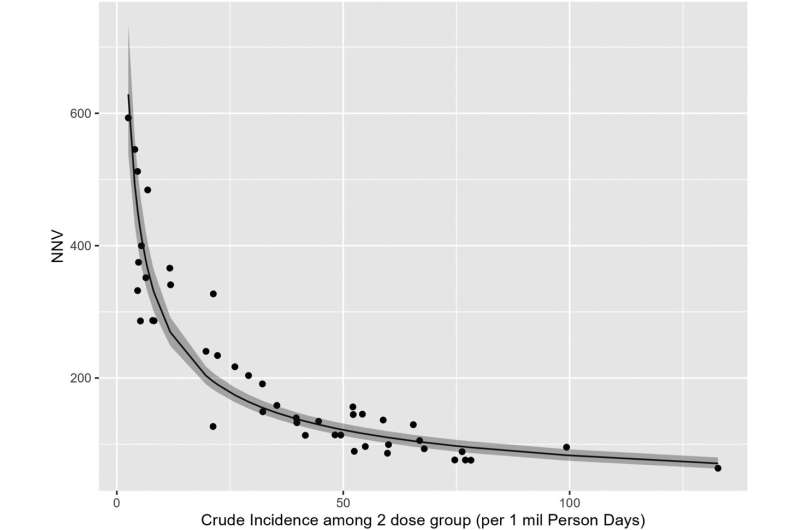This article has been reviewed according to Science X's editorial process and policies. Editors have highlighted the following attributes while ensuring the content's credibility:
fact-checked
trusted source
proofread
Large study determines number of adults who need to be vaccinated to prevent COVID-19 hospitalizations and ED visits

An analysis of real-world data from more than 1.2 million patients from health systems in four geographically dispersed states—Indiana, Oregon, Texas and Utah—conducted by the U.S. Centers for Disease Control and Prevention's VISION Network, has determined both the number of adults needed to be vaccinated to prevent one COVID-19 associated hospitalization and the number needed to be vaccinated to prevent one COVID-19 associated emergency department (ED) visit.
This study is one of the first, largest and most comprehensive studies to present clear measurement, by age groups, of how widespread vaccination needs to be to provide protection against serious and moderate disease in adults.
Preventing a hospitalization indicates that vaccination provided protection against severe disease. Preventing an ED visit indicates that vaccination provided protection against moderate disease.
"The number needed to be vaccinated or more technically, 'number needed to vaccinate,' comes from the related concept of 'number needed to treat'—how many must be treated to avoid one bad outcome. One can think of number needed to treat or vaccinate as similar to how much gas you need, or how hard you need to push on the gas pedal to accelerate," said study co-author Shaun Grannis, M.D., M.S., Regenstrief Institute Vice President for Data and Analytics and the Regenstrief Professor of Medical Informatics at Indiana University of School of Medicine.
"Knowing the number of patients who need to be vaccinated is a way of measuring how effective the vaccine is. The lower the number of patients needed to be vaccinated, the more effective the vaccine. If we can prevent more hospitalizations with fewer vaccinations, that's important to know."
"Knowing the number of patients needed to be vaccinated helps us plan on the volume of vaccine needed and the type of awareness and education that we want to provide. This number informs decision-making processes by public health officials, vaccine producers, health systems and others."
The study found that the number of patients needed to be vaccinated to prevent one COVID-19-associated hospitalization was higher than the number needed to vaccinate to prevent one COVID-19 associated ED visit, reflecting differences in outcome severity. These numbers were dependent on patient risk factors as well as local disease incidence.
The number needed to be vaccinated to prevent one COVID-19-associated hospitalization ranged from 44 to 615 (median was 205) individuals and was lower for adults aged 65 years or older and for those with underlying medical conditions. The number needed to be vaccinated decreased as the population became older because older individuals are more susceptible to the adverse effects of the virus and, therefore, the vaccine provides greater protection.
The number of patients needed to be vaccinated to prevent COVID-19-associated ED visits showed a different pattern because vaccines were more effective at preventing ED visits among younger adults than older ones. The median number needed to be vaccinated to prevent one ED visit ranged from 75 to 592 (median was 156) individuals.
Information from patients who had received either two or three mRNA vaccine doses was analyzed. None were immunocompromised. Data was from December 2021- February 2022, a period of Omicron BA.1 variant predominance.
"The reason why the number of patients needed to be vaccinated to prevent a COVID-19 related hospitalization is different from the number needed to prevent an ED (Emergency Department) visit is not fully understood, but it is likely because of how people seek health care. Many people, especially younger ones who lack health insurance or Medicare, are more likely to use the ED for primary health care. On the other hand, older people usually go to their regular doctor instead of going to the ED," Dr. Grannis observed.
The paper is published in The Lancet Regional Health—Americas.
More information: Katherine Adams et al, Number needed to vaccinate with a COVID-19 booster to prevent a COVID-19-associated hospitalization during SARS-CoV-2 Omicron BA.1 variant predominance, December 2021–February 2022, VISION Network: a retrospective cohort study, The Lancet Regional Health—Americas (2023). DOI: 10.1016/j.lana.2023.100530





















